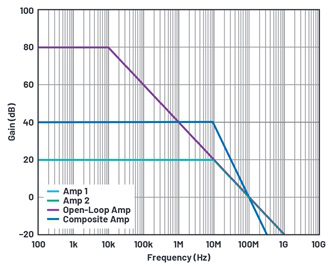“Engineers are often challenged with the constant need to develop new applications to meet a wide range of needs. In general, these requirements are difficult to satisfy simultaneously. For example, a high-speed, high-voltage operational amplifier (op amp) with high output power and equally good DC accuracy, noise and distortion performance. It’s rare to find an op amp on the market that combines all of these characteristics. However, you can build this type of amplifier using two separate amplifiers, forming a composite amplifier. By combining two op amps, the advantageous features of each can be integrated into one.In this way, compared to a single amplifier with the same gain
“
By: Thomas Brand, Field Applications Engineer, Analog Devices
Engineers are often challenged with the constant need to develop new applications to meet a wide range of needs. In general, these requirements are difficult to satisfy simultaneously. For example, a high-speed, high-voltage operational amplifier (op amp) with high output power and equally good DC accuracy, noise and distortion performance. It’s rare to find an op amp on the market that combines all of these characteristics. However, you can build this type of amplifier using two separate amplifiers, forming a composite amplifier. By combining two op amps, the advantageous features of each can be integrated into one. In this way, the combination of two op amps can achieve higher bandwidth than a single amplifier with the same gain.
composite amplifier
A composite amplifier consists of a combination of two separate amplifiers, each with different characteristics. Figure 1 shows this structure. Amplifier 1 is the low noise precision amplifier ADA4091-2. In this example, amplifier 2 is the AD8397, which has high output power and can be used to drive other modules.

Figure 1. Schematic diagram of two op amps in series to form a composite amplifier
The configuration of the composite amplifier shown in Figure 1 is similar to that of a noninverting amplifier with two external operating resistors R1 and R2. Think of two op amps in series as one amplifier. The overall gain (G) is set by the resistor ratio, G = 1 + R1/R2. If the resistance ratio of R3 to R4 is changed, it will affect the gain of Amplifier 2 (G2), and it will also affect the gain or output level of Amplifier 1 (G1). However, R3 and R4 do not change the effective overall gain. If G2 decreases, G1 will increase.
Bandwidth expansion
Another characteristic of composite amplifiers is their higher bandwidth. A composite amplifier has a higher bandwidth than a single amplifier. So, using two identical amplifiers with a gain-bandwidth product (GBWP) of 100 MHz and a gain of G = 1, the C3 dB bandwidth can be increased by about 27%. The higher the gain, the more pronounced the effect, but only up to a certain limit. Once the limit is exceeded, it may become unstable. This instability also occurs when the two gains are not equally distributed. In general, the maximum bandwidth is obtained when the gains of both amplifiers are equally distributed. Using the above values (GBWP = 100 MHz, G2 = 3.16, G = 10), at a total gain of 10, the combined C3 dB bandwidth of the two amplifiers can be three times that of a single amplifier.
This description is relatively simple. When the gain is evenly distributed, G2 also achieves the same effective gain as Amplifier 1. However, the open loop gain of each individual amplifier is higher. At lower gain, for example, from 40 dB down to 20db, both amplifiers operate in the low region of the open-loop curve (see Figure 2). In this way, a composite amplifier can achieve higher bandwidth than a single amplifier with the same gain.

Figure 2. Extending Bandwidth with Composite Amplifiers
DC Accuracy and Noise
In a typical op amp circuit, part of the output is fed to the inverting input. In this way, the output error can be corrected through the feedback path to improve accuracy. The combination shown in Figure 1 also provides a separate feedback path for amplifier 2, although it is also in the feedback path of amplifier 1. The overall configuration output will have a larger error due to Amplifier 2, but when fed back to Amplifier 1, this error will be corrected. Therefore, the accuracy of the amplifier 1 can be maintained. The output offset is only proportional to the input offset error of the first amplifier, independent of the offset voltage of the second amplifier.
The same goes for the noise component. It is also corrected by feedback, where the AC signal is related to the bandwidth reservation of the two amplifier stages. As long as the first amplifier stage has sufficient bandwidth, it will correct the noise component of amplifier 2. So far, its output voltage noise density dominates. However, if the bandwidth of amplifier 1 is exceeded, the noise component of the second amplifier starts to dominate. Problems can arise if the bandwidth of amplifier 1 is too high, or much higher than that of amplifier 2. This can lead to additional noise peaks in the output of the composite amplifier.
in conclusion
By connecting two amplifiers in series, the excellent characteristics of both can be combined to achieve results that cannot be achieved with a single op amp. For example, high-precision amplifiers with high output power and high bandwidth can be realized. The example circuit shown in Figure 1 uses the AD8397 rail-to-rail amplifier (C3 dB bandwidth = 69 MHz) and the precision amplifier ADA4091-2 (C3 dB bandwidth = 1.2 MHz), combining the two to give a higher bandwidth than a single amplifier (Amplifier 1 ) is more than 2 times higher bandwidth (G = 10). In addition, combining the AD8397 with various precision amplifiers can also reduce noise and improve THD characteristics. However, in the design, the stability of the system must also be ensured by modifying the amplifier configuration. If all criteria are considered, composite amplifiers may also be suitable for a wide variety of demanding applications.
author

Thomas Brand
Thomas Brand joined ADI in Munich, Germany, in October 2015 while he was still studying for a master’s degree. From May 2016 to January 2017, he participated in the Field Application Engineer Trainee Program at Analog Devices. Then in February 2017, he took up the position of Field Application Engineer, mainly responsible for large industrial accounts. In addition, he focuses on research on Industrial Ethernet and provides support for related topics in Central Europe. He graduated in electrical engineering from the Joint Education University in Mosbach, Germany, and then obtained a master’s degree in international sales from the University of Applied Sciences Konstanz, Germany.